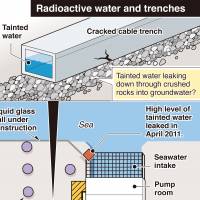Tokyo Electric Power Co. only recently admitted radioactive water is flowing from its crippled Fukushima No. 1 plant into the Pacific.
Although Tepco is giving assurances that it is taking and planning steps to prevent more tainted groundwater from reaching the sea, it's unclear how effective those efforts are, considering the difficulty of even pinpointing the problem.
Here are questions and answers regarding the tainted flow.
When was the leak noticed?
According to Tepco, the utility began more closely monitoring the radiation levels of groundwater in wells 25 meters from shore in May.
In June, the utility announced it had detected high levels of radioactive material in the groundwater taken from the wells near the reactor 2 turbine building.
Though the groundwater flows toward the sea, Tepco initially ruled out the possibility it was reaching the Pacific.
Last week, it finally changed its tune. The firm said data showed the well water levels were changing with the tides, indicating the seawater and the groundwater are intermingling.
How did the groundwater become radioactive?
Inside trenches connecting the reactor 2 turbine building and a pump room right by the shore, there are pipes to carry seawater for cooling as well as electrical cables.
Since the start of the Fukushima crisis, tainted water has accumulated in these trenches, which rest on highly permeable gravel. Experts believe radioactive water is leaking from cracks in the trenches and passing through the rushed rock, reaching the groundwater.
"It's very important information that there is crushed rock (under the trenches)," Kunihiko Shimazaki, a commissioner at the Nuclear Regulation Authority, told an NRA meeting last week.
Tepco also suspects that residual water from a leak of highly radioactive water that reached the Pacific through a section of the trenches in April 2011 may be a source of the groundwater contamination.
A sample taken last Friday from the trench contained 750 million becquerels of cesium-134, 1.6 billion becquerels of cesium-137 and 750 million becquerels of other radioactive substances, according to Tepco.
A sample from April 2011 contained 1.8 billion becquerels of both cesium-134 and cesium-137 per liter.
Meanwhile, the basement of the turbine building is flooded with the tainted water from a leaking containment vessel. Radioactive water there is possibly leaking into the trenches connected to the basement.
How much radioactive water has flowed into the sea?
Tepco said it is unclear how long tainted water has been leaking into the sea — or how much. It continues to claim that the contamination of the sea is limited to the plant's port.
What is Tepco doing to stop the flow?
Tepco is trying to remove the source of contamination and block the flow of the tainted groundwater. It is currently injecting liquid glass between the reactor 2 turbine building and the sea, hoping the glass will serve as a wall to stop the groundwater from reaching the Pacific.
Tepco also plans to build a wall in the immediate harbor to contain the radioactive water. Its construction won't be completed until September 2014. The utility is also planning to remove and process the tainted water in the trenches and backfill a part of them with filling materials.
Are such measures enough to end the problem?
Experts remain uncertain.
"The underground situation is complex. It's not necessarily easy to figure out," said Shigeaki Tsunoyama, president of the University of Aizu, one of the NRA panel members monitoring the Fukushima No. 1 plant.
"Building walls seems simple in a drawing, but when you think about a complex underground structure, it won't be that easy," he said, adding that it is still not certain where exactly the contamination is coming from.
Although it is a difficult job, Tsunoyama said Tepco should try to figure out what is really going on underneath the plant.
The NRA also urged Tepco to dig more wells to determine how far the radioactive groundwater has spread. Reactors 1, 2 and 3 all suffered core meltdowns, and unit 4's building was destroyed in a hydrogen explosion, exposing its spent-fuel pool.
There are monitoring wells around the other damaged reactors, but unit 2 appears to so far be the only area where radioactive groundwater is showing up.



